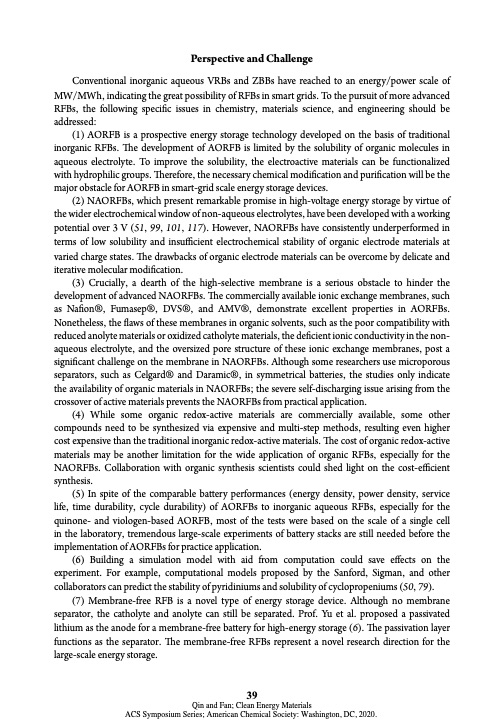
PDF Publication Title:
Text from PDF Page: 039
Perspective and Challenge Conventional inorganic aqueous VRBs and ZBBs have reached to an energy/power scale of MW/MWh, indicating the great possibility of RFBs in smart grids. To the pursuit of more advanced RFBs, the following specific issues in chemistry, materials science, and engineering should be addressed: (1) AORFB is a prospective energy storage technology developed on the basis of traditional inorganic RFBs. The development of AORFB is limited by the solubility of organic molecules in aqueous electrolyte. To improve the solubility, the electroactive materials can be functionalized with hydrophilic groups. Therefore, the necessary chemical modification and purification will be the major obstacle for AORFB in smart-grid scale energy storage devices. (2) NAORFBs, which present remarkable promise in high-voltage energy storage by virtue of the wider electrochemical window of non-aqueous electrolytes, have been developed with a working potential over 3 V (51, 99, 101, 117). However, NAORFBs have consistently underperformed in terms of low solubility and insufficient electrochemical stability of organic electrode materials at varied charge states. The drawbacks of organic electrode materials can be overcome by delicate and iterative molecular modification. (3) Crucially, a dearth of the high-selective membrane is a serious obstacle to hinder the development of advanced NAORFBs. The commercially available ionic exchange membranes, such as Nafion®, Fumasep®, DVS®, and AMV®, demonstrate excellent properties in AORFBs. Nonetheless, the flaws of these membranes in organic solvents, such as the poor compatibility with reduced anolyte materials or oxidized catholyte materials, the deficient ionic conductivity in the non- aqueous electrolyte, and the oversized pore structure of these ionic exchange membranes, post a significant challenge on the membrane in NAORFBs. Although some researchers use microporous separators, such as Celgard® and Daramic®, in symmetrical batteries, the studies only indicate the availability of organic materials in NAORFBs; the severe self-discharging issue arising from the crossover of active materials prevents the NAORFBs from practical application. (4) While some organic redox-active materials are commercially available, some other compounds need to be synthesized via expensive and multi-step methods, resulting even higher cost expensive than the traditional inorganic redox-active materials. The cost of organic redox-active materials may be another limitation for the wide application of organic RFBs, especially for the NAORFBs. Collaboration with organic synthesis scientists could shed light on the cost-efficient synthesis. (5) In spite of the comparable battery performances (energy density, power density, service life, time durability, cycle durability) of AORFBs to inorganic aqueous RFBs, especially for the quinone- and viologen-based AORFB, most of the tests were based on the scale of a single cell in the laboratory, tremendous large-scale experiments of battery stacks are still needed before the implementation of AORFBs for practice application. (6) Building a simulation model with aid from computation could save effects on the experiment. For example, computational models proposed by the Sanford, Sigman, and other collaborators can predict the stability of pyridiniums and solubility of cyclopropeniums (50, 79). (7) Membrane-free RFB is a novel type of energy storage device. Although no membrane separator, the catholyte and anolyte can still be separated. Prof. Yu et al. proposed a passivated lithium as the anode for a membrane-free battery for high-energy storage (6). The passivation layer functions as the separator. The membrane-free RFBs represent a novel research direction for the large-scale energy storage. 39 Qin and Fan; Clean Energy Materials ACS Symposium Series; American Chemical Society: Washington, DC, 2020.PDF Image | Electroactive Materials Next-Generation Redox Flow Batteries

PDF Search Title:
Electroactive Materials Next-Generation Redox Flow BatteriesOriginal File Name Searched:
bk-2020-1364.ch001.pdfDIY PDF Search: Google It | Yahoo | Bing
Salgenx Redox Flow Battery Technology: Salt water flow battery technology with low cost and great energy density that can be used for power storage and thermal storage. Let us de-risk your production using our license. Our aqueous flow battery is less cost than Tesla Megapack and available faster. Redox flow battery. No membrane needed like with Vanadium, or Bromine. Salgenx flow battery
| CONTACT TEL: 608-238-6001 Email: greg@salgenx.com | RSS | AMP |